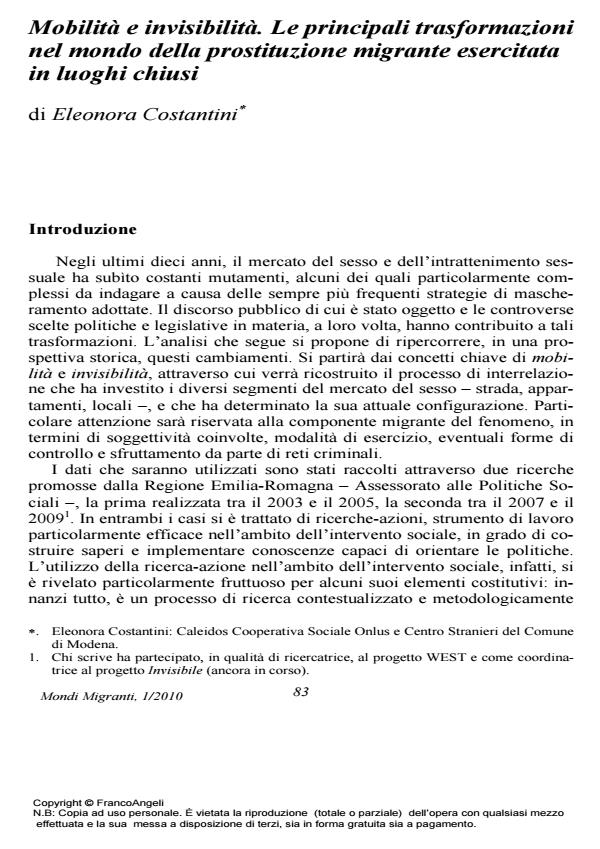Mobilità e invisibilità. Le principali trasformazioni nel mondo della prostituzione migrante esercitata in luoghi chiusi
Journal title MONDI MIGRANTI
Author/s Eleonora Costantini
Publishing Year 2010 Issue 2010/1
Language Italian Pages 20 P. File size 515 KB
DOI 10.3280/MM2010-001004
DOI is like a bar code for intellectual property: to have more infomation
click here
Below, you can see the article first page
If you want to buy this article in PDF format, you can do it, following the instructions to buy download credits

FrancoAngeli is member of Publishers International Linking Association, Inc (PILA), a not-for-profit association which run the CrossRef service enabling links to and from online scholarly content.
In the last ten years, prostitution has been object of several changes, some of which have been particularly difficult to study as a result of the increased use of strategies for hiding the sale of sexual services and the related exploitation, in private apartments or leisure clubs, especially of the migrant side. The present study is aimed at using the main principles of migration sociology in order to analyse the said changes starting from the concepts of mobility and visibility, taking data and information from two studies carried out between 2003 and 2005 and 2007-2008 in Emilia Romagna. Nowadays, the market of prostitutions is extremely varied internally and comprises at least three main segments, which are functionally interconnected: the street level, the apartment level and the club level. With regard to the type of subjects involved, the main group is that of migrants, both women and transsexuals. Furthermore, prostitution in closed places has favoured the transformation and growth of the support network needed for the good functioning of the market: prostitution in private apartments, for instance, requires the cooperation of estate agents or intermediaries, control or safeguard figures or other sovra-local agencies able to deal with work transfers between different cities. In addition, clubs are also gradually becoming pubs or cafes, dancing clubs or disco-clubs, where people mainly gather to have a drink, listen to music and where they can watch the (female) entertainers’ performance. In this newly-changed market, today migrants see prostitution as a fruitful job allowing them a social mobility, also in their homeland; hence the idea of repeating the same migrating patterns aimed at getting rich in short periods of time. However, the debt accumulated to pay travel expenses and logistic expenses in the country of destination transforms prostitution in a wearing activity, that is to say a resource that may downgrade the migrating pattern. In this sense, the main elements of prostitution are lower-level competition within the market; the individual investment required in terms of economic and physical resources; the risks associated with the job resulting from the deviated nature of the market; and finally, the expertise and specialisation acquired by criminal networks in the many activities linked to prostitution in apartments and clubs.
Eleonora Costantini, Mobilità e invisibilità. Le principali trasformazioni nel mondo della prostituzione migrante esercitata in luoghi chiusi in "MONDI MIGRANTI" 1/2010, pp , DOI: 10.3280/MM2010-001004